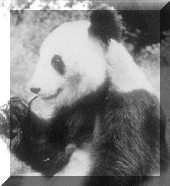


Giant Panda
STATUS: Endangered
DESCRIPTION: Legs, shoulders, ears and the oval patches
around eyes are all black. Rest of coat is white. Coloring acts as camouflage when the
animal moves across the snow. good tree climber and can even swim to escape a predator.
Holds bamboo with an enlarged wrist bone that looks like a thumb. Hairs on the soles of
the feet give it traction and reduce heat loss on the ice and snow. Some scientists
disagree whether the giant panda is a type of bear or raccoon. Others believe it is
separate from either bears or raccoons.
SIZE: Length: 6 feet. Weight: 200-300 pounds. Tiny at
birth, weighing only 1/2 pound.
HABITAT: Thick bamboo and coniferous forests
(evergreens with pine cones), 8,500- 11,500 feet in elevation. Heavy clouds, rain and
mists cover these mountains all year.
RANGE: Szechuan, Shensi and Kansu provinces of Central
and Western China.
FOOD SOURCE: Mostly bamboo, a tall woody plant full of
good fiber. The panda's digestive system does not absorb the fiber, so it must eat a lot
of it. Pandas also eat flowers, vines, tufted grasses, green corn, honey and rodents.
BEHAVIOR: Solitary animals. Spend most of its day
feeding. Although it is cold in the forest, pandas do not hibernate. They move to lower
elevations during the winter to stay warm and to higher elevations in the winter to stay
cool. they do not have permanent homes, but sleep at the bottom of trees and under stumps
and rock ledges.
REPRODUCTION: Gestation period of 125-150 days. A
litter of one or two are born, but only one is reared. Eyes open at 1.5-2 months and the
cubs start to move around at 3 months. Weaned at 6 months and become independent at one
year.
POPULATION: 1,000 in the wild; 60 in captivity in zoos.
LONGEVITY: Unknown in the wild; over 20 years in
captivity.
SURVIVAL THREATS: Habitat loss due to increasing human
populations, poaching, and periodic bamboo die-off. Captive-breeding attempts have not
been very successful.
LEGAL PROTECTION: CITES, Appendix I, Endangered Species
Act.
CONSERVATION: Habitat protection, captive breeding,
stiff penalties for those harming pandas, and public education.
